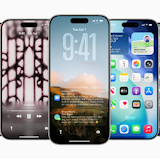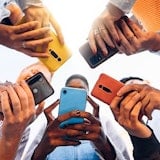
- Faster CPU and AI
- Improved cameras
- Longer battery life
- More onboard storage

- Cheaper (though still expensive)
- 5G on supported Canadian networks
- Full HD+ OLED display
- MagSafe charging and accessories

Both the Apple iPhone 13 and iPhone 12 are older models and as such, enjoy reduced pricing while still delivering top-notch functionality. The iPhone 13 features minor upgrades to performance, cameras, and battery life compared to the 12, but the display and connectivity options aren’t significantly different.
The experts at WhistleOut compare the iPhone models so you can decide if it’s worth the extra $80 (yes, just an $80 retail difference). We also answer your most pressing questions about Apple’s iPhone family.
iPhone 13 vs. iPhone 12 summary
This is a tight race, as the newer iPhone 13 is only incrementally better, while the iPhone 12 boasts a lower entry price. Some hardware, including the CPU, camera sensors, and battery, received upgrades. Still, many desired features—including 5G and Wi-Fi connectivity, OLED display, and MagSafe accessories—are the same on both devices.
iPhone 13 vs. iPhone 12: Performance
Even more dependable than the onset of winter in Canada is Apple’s release of a faster iPhone. The new A15 Bionic CPU features a faster neural engine for improved AI performance. The new display engine accelerates video encoding and decoding. These changes translate into performance improvements across every app and feature on the iPhone 13.

- New A15 Bionic CPU with Neural engine
- New video encoder/decoder
- 2x the onboard storage

- Still has better 3D than any Android
- The base model has only 64GB
The iPhone 13 further improves mobile gaming performance, but the iPhone 12 is no slouch either. In fact, even the iPhone 11 offers better 3D gaming graphics than the fastest Android smartphones. Apple has positioned itself so far ahead of its competitors when it comes to mobile performance that they’re really only competing with themselves. Even though the iPhone 13 is the champion when we’re talking about raw performance, there’s no shame for the iPhone 12 coming in second.
Winner: iPhone 13
iPhone 13 vs. iPhone 12: Cameras
The rear camera lenses on the iPhone 13 feature a new diagonal layout; it’s also the easiest way to differentiate this model from an older iPhone 12. The extra space lets Apple use larger sensors that pull in more light, vastly improving detail in low-light situations indoors and at night.

- Larger light sensors
- Better OIS
- Cinematic Mode and Photographic Styles
- The iPhone 13 Pro adds more features

- Two rear and one front camera work well in sync
- Still a feature-rich experience
- Missing features in the iPhone 12 Pro
Optical image stabilization (OIS) is also improved thanks to sensor-shift OIS. Instead of moving the lens to compensate for an unsteady hand, the camera sensor moves, allowing your video to be steady even when you are not. Last year, this feature was exclusive to the top-tier iPhone 12 Pro Max but is now available on all iPhone 13 models down to the cheapest iPhone 13 mini.
The faster processor plays a part in a better camera experience, too. The neural engine in the A15 Bionic CPU improves performance on your favourite visual effects, Smart HDR, and enables new features like Cinematic Mode recording. The iPhone 13 even lets you set your own default Photographic Styles, so every photo you take exhibits your own personal fingerprint.
Again, all these upgrades are incremental. The iPhone 12 camera hardware and software are still among the best in the market, but the new iPhone 13’s offerings are just better.
Winner: iPhone 13
iPhone 13 vs. iPhone 12: Display
Last year, Apple sharply reduced the display quality gap between the cheapest iPhone 12 and the premium iPhone Pro. For the iPhone 13 series, Apple engineers vastly improved the technology in iPhone 13 Pro displays, while the basic iPhone 13 retains many of the same hardware specs.
Look closely enough, and you’ll notice that the “notch” is finally smaller for the first time since it was introduced on the iPhone X nearly four years ago. A more subtle upgrade is the higher typical maximum brightness on the new iPhone 13 (800 nits vs. 625 nits). While technically a better screen in these two regards, the iPhone 13’s display is nearly identical to the one on last year’s iPhone 12.
Winner: Tie
iPhone 13 vs. iPhone 12: Battery Life
Just like you move things around on a shelf to make more space, Apple rearranged the internal components of the iPhone 13 to make room for a larger battery. The entire iPhone 13 family features a longer battery life than last year’s models.

- Longer battery life
- 50% charge in 30 minutes (on 20W charger)
- MagSafe charging
- No charger included

- 50% charge in 30 minutes (on 20W charger)
- MagSafe charging
- No charger included
When it comes to charging, there’s nothing new to talk about. The iPhone 12 introduced MagSafe wireless charging and accessories, and it can charge up the battery to 50% in as little as 30 minutes with a 20W power adaptor plug. However, you’ll need to buy that charger separately as there isn’t one included among the iPhone 13’s reduced packaging—another “feature” introduced with the iPhone 12.
Winner: iPhone 13
iPhone 13 vs. iPhone 12: Connectivity
Although early rumours hinted at satellite connectivity, the iPhone 13 shows no changes to cellular or wireless connectivity. In fact, aside from 5G—which was added to the line last year—there have been no significant communications upgrades since the iPhone 11!
Both the iPhone 12 and iPhone 13 support gigabit 4G LTE and 5G connectivity on all Canadian cell phone networks. All iPhone 12 and iPhone 13 models support Wi-Fi 6 (802.11ax) with MIMO and Bluetooth 5.0, but that’s still a little disappointing.
Our experts were hoping for Bluetooth 5.2 for superior sound and power efficiency and Wi-Fi 6E, which improves connectivity on home networks with lots of wireless devices. We expect these shortcomings to be addressed before Apple releases a portless iPhone sometime in the near future.
Winner: No one
iPhone 13 vs. iPhone 12: Price
Obviously, the older iPhone 12 is cheaper than the most current model, but is the price difference worth it? The answer is more complicated than comparing features because the new base model iPhone 13 includes twice as much storage as the starter iPhone 12. To accurately compare the two generations, we need to compare by storage options:
iPhone 13 vs. iPhone 12: Price by storage
| 64GB | 128GB | 256GB | 512GB | |
|---|---|---|---|---|
| iPhone 12 | $949 | $1,019 | $1,159 | — |
| iPhone 13 | — | $1,099 | $1,239 | $1,509 |
| iPhone 12 mini | $799 | $869 | $1,009 | — |
| iPhone 13 mini | — | $949 | $1,089 | $1,359 |
Once we account for storage options, the cost across the board of all that upgraded hardware in the iPhone 13 is only $80 more. That’s an outstanding value, especially when spread over 24 monthly payments (~$3.33/month).

- Same or similar to last year's models
- Just $80 more than current iPhone 12 prices
- Only one model (128GB iPhone 13 mini) under $1,000

- New, reduced retail price, but still high
- A good deal if you find one on sale
If you think you can get away with just 64GB of storage, then you’d save $150 when buying the iPhone 12, so that might be worth it depending on your needs. For that reason, we’re giving the win to iPhone 12, but we highly recommend waiting for a promotional deal that further reduces the price.
Winner: iPhone 12
iPhone 13 vs. iPhone 12: Recap
Apple continues to set a high standard for smartphones with every new generation. The iPhone 13 is no exception to that trend with its faster performance, better cameras, and longer battery life. However, many other features, including the display, are only marginally better, while wireless and cellular connectivity offer nothing new. Apple decided to keep the iPhone 12 and iPhone 12 mini around as a cheaper option, but you only save $80 CAD compared to an iPhone 13 with the same amount of memory. If you’re thinking about buying an iPhone 12, you should seriously consider throwing down an extra 80 bucks for the newest model
On the other hand, the entry-level iPhone 12 with 64GB of storage will be frequently discounted over the next year as part of carrier promotions. This makes it a good option for money-conscious Apple fanatics. After all, Apple’s only competing with itself when it comes to making the fastest smartphone; the iPhone 12 is still more powerful than any Android smartphone on the market.
iPhone 13 vs. iPhone 12: Frequently Asked Questions
What’s different about the iPhone 13?
There are several incremental improvements to this year’s iPhone. The new A15 Bionic processor in the iPhone 13 is faster, the camera sensors are larger to improve light detection, and the battery life is significantly improved. However, the display and wireless connectivity received no upgrades.
Is the iPhone 13 compatible with 5G?
Just like the iPhone 12 before it, the new iPhone 13 models sold in Canada support 5G on existing wireless networks from Rogers, Bell, Telus, and Videotron. At this time, there are no Canadian wireless providers who support high-band 5G—also called mmWave—so Apple is restricting sales of mmWave iPhone models to the United States. Refer to our 5G Availability in Canada page to find out when this ultra-fast wireless technology rolls out.
Does iPhone 13 look like the iPhone 12?
The size and shape of the iPhone 13 are nearly identical to the iPhone 12. Both devices are 146.7mm high by 71.5mm wide. However, the iPhone 13 is 2.5mm thicker, and the larger camera bump leads to one sad truth…(see next question).
Can I use my iPhone 12 case on an iPhone 13?
You won’t be able to use your favourite case after upgrading from an iPhone 12 to an iPhone 13. A slightly thicker profile offers a bigger battery and larger lenses result in better photos, but you will need to buy a new protective case.
What colours does the iPhone 13 come in?
The iPhone 13 is available in Starlight (white), Midnight (black), blue, pink, and (PRODUCT)RED. Last year’s iPhone 12 launched in white, black, blue, green, and (PRODUCT)RED, but added a purple colour in 2021.
Which is better, the Apple iPhone 13 Pro or iPhone 12 Pro?
While the iPhone 13 received minor upgrades to the CPU, cameras, and battery life, the real story is the improvements to Apple’s iPhone 13 Pro and iPhone 13 Pro Max. The display on the iPhone 12 Pro only runs at a 60Hz refresh rate… which is nice… but the iPhone 13 Pro series uses a new 120Hz ProMotion display. In addition to being 2x faster, it can drop the frame rate down to just 10 frames per second when motion isn’t important in order to save battery life.
In addition to the performance upgrades found on the base model, the iPhone 13 Pro family gets some other perks, including a longer optical zoom range between the ultra-wide camera, the wide, and the telephoto lens. Coming soon, the iPhone 13 Pro will record in Apple ProRes video up to 4K at 30fps, so there’s a new 1TB storage option to help with those large files. If you were holding back on getting an iPhone 12 Pro model for any reason, this year’s Pro family is a much more worthwhile investment.
Methodology
WhistleOut’s team of mobile experts used proprietary research to evaluate the iPhone 12 and iPhone 13. Where possible, we tested and compared the devices and according to performance, cameras, display, battery life, connectivity, and price. We itemized significant differences and broke our findings down to further evaluate specific features of both phones, like value for the dollar.
Based on our extensive industry experience, we weighed the benefits of each device’s options based on the needs of an average user and chose a winner that would suit most customers’ needs. We only compared the Apple iPhone 13 vs. iPhone 12—no other manufacturer’s offerings influence our evaluations.
Related Articles
Find Better Phones and Plans
Hundreds of cell phone plans unpacked. All the facts. No surprises.




 Apple's 2021 model featuring new Ultra Wide and Wide cameras with sensor-shift image stabilization, 5G Apple's 2021 model featuring new Ultra Wide and Wide cameras, new sensor-shift image stabilization, Cinematic mode, more 5G bands, 6.1" Super Retina XDR display and more battery speed, 6.1" Super Retina XDR display and Ceramic Shield
Apple's 2021 model featuring new Ultra Wide and Wide cameras with sensor-shift image stabilization, 5G Apple's 2021 model featuring new Ultra Wide and Wide cameras, new sensor-shift image stabilization, Cinematic mode, more 5G bands, 6.1" Super Retina XDR display and more battery speed, 6.1" Super Retina XDR display and Ceramic Shield



 Apple's 2020 cheaper model with 5G speed, dual 12MP Ultra Wide and Wide cameras with Night mode, 12MP TrueDepth camera, 6.1" all-screen OLED display with Ceramic Shield and longer battery
Apple's 2020 cheaper model with 5G speed, dual 12MP Ultra Wide and Wide cameras with Night mode, 12MP TrueDepth camera, 6.1" all-screen OLED display with Ceramic Shield and longer battery





































